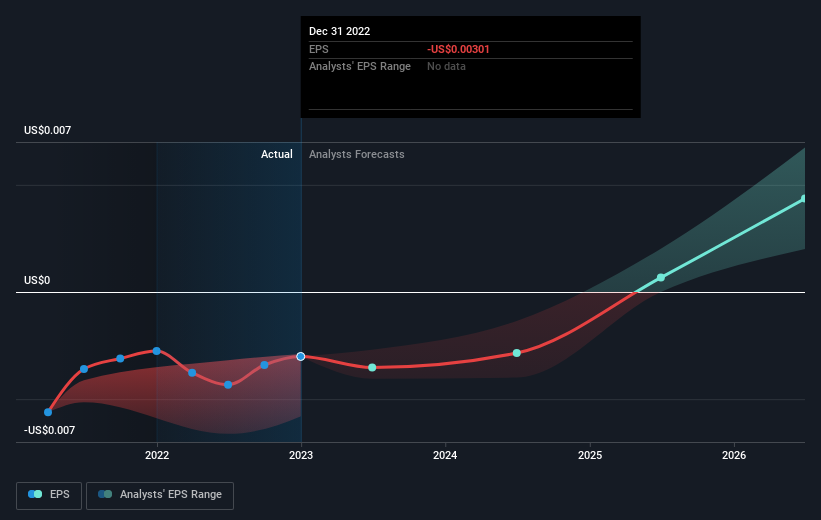Seeing Machines Limited (LON:SEE) Is Expected To Breakeven In The Near Future

With the business potentially at an important milestone, we thought we'd take a closer look at Seeing Machines Limited's (LON:SEE) future prospects. Seeing Machines Limited, together with its subsidiaries, provides driver and occupant monitoring system technologies in Australia, North America, the Asia Pacific, Europe, and internationally. The UK£236m market-cap company’s loss lessened since it announced a US$17m loss in the full financial year, compared to the latest trailing-twelve-month loss of US$13m, as it approaches breakeven. Many investors are wondering about the rate at which Seeing Machines will turn a profit, with the big question being “when will the company breakeven?” Below we will provide a high-level summary of the industry analysts’ expectations for the company.
Check out our latest analysis for Seeing Machines
According to the 3 industry analysts covering Seeing Machines, the consensus is that breakeven is near. They anticipate the company to incur a final loss in 2024, before generating positive profits of US$3.3m in 2025. Therefore, the company is expected to breakeven roughly 2 years from today. What rate will the company have to grow year-on-year in order to breakeven on this date? Using a line of best fit, we calculated an average annual growth rate of 70%, which is rather optimistic! Should the business grow at a slower rate, it will become profitable at a later date than expected.

We're not going to go through company-specific developments for Seeing Machines given that this is a high-level summary, but, keep in mind that by and large a high forecast growth rate is not unusual for a company that is currently undergoing an investment period.
One thing we would like to bring into light with Seeing Machines is its relatively high level of debt. Generally, the rule of thumb is debt shouldn’t exceed 40% of your equity, which in Seeing Machines' case is 44%. A higher level of debt requires more stringent capital management which increases the risk in investing in the loss-making company.
Next Steps:
There are key fundamentals of Seeing Machines which are not covered in this article, but we must stress again that this is merely a basic overview. For a more comprehensive look at Seeing Machines, take a look at Seeing Machines' company page on Simply Wall St. We've also put together a list of essential factors you should further research:
- Historical Track Record: What has Seeing Machines' performance been like over the past? Go into more detail in the past track record analysis and take a look at the free visual representations of our analysis for more clarity.
- Management Team: An experienced management team on the helm increases our confidence in the business – take a look at who sits on Seeing Machines' board and the CEO’s background.
- Other High-Performing Stocks: Are there other stocks that provide better prospects with proven track records? Explore our free list of these great stocks here.
If you're looking to trade Seeing Machines, open an account with the lowest-cost platform trusted by professionals, Interactive Brokers.
With clients in over 200 countries and territories, and access to 160 markets, IBKR lets you trade stocks, options, futures, forex, bonds and funds from a single integrated account.
Enjoy no hidden fees, no account minimums, and FX conversion rates as low as 0.03%, far better than what most brokers offer.
Sponsored ContentNew: Manage All Your Stock Portfolios in One Place
We've created the ultimate portfolio companion for stock investors, and it's free.
• Connect an unlimited number of Portfolios and see your total in one currency
• Be alerted to new Warning Signs or Risks via email or mobile
• Track the Fair Value of your stocks
Have feedback on this article? Concerned about the content? Get in touch with us directly. Alternatively, email editorial-team (at) simplywallst.com.
This article by Simply Wall St is general in nature. We provide commentary based on historical data and analyst forecasts only using an unbiased methodology and our articles are not intended to be financial advice. It does not constitute a recommendation to buy or sell any stock, and does not take account of your objectives, or your financial situation. We aim to bring you long-term focused analysis driven by fundamental data. Note that our analysis may not factor in the latest price-sensitive company announcements or qualitative material. Simply Wall St has no position in any stocks mentioned.
About AIM:SEE
Seeing Machines
Provides driver and occupant monitoring system technologies in Australia, North America, the Asia Pacific, Europe, and internationally.
Fair value with mediocre balance sheet.
Similar Companies
Market Insights
Community Narratives



